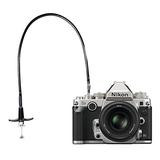Why You Need a Cable Release for Bulb Mode

A cable release not only minimizes camera shaking, it also has the ability to lock down the shutter button for bulb mode which is extremely useful for long exposure photography.
WHAT IS BULB MODE?
Bulb mode, denoted by a B allows the photographer to manually open and close the shutter for the desired exposure. Select manual mode or shutter priority, then scroll your selector wheel all the way to the end of the shutter speeds. After 25″ (25 seconds), 30″, it will show “bulb” or the letter “b” on some cameras. In bulb mode the camera will keep capturing a picture until your finger leaves the shutter button.
Bulb mode is mainly used for long exposures at low light. It allows shutter speeds longer than the 30 seconds (30″) that is allowed on most DSLRs.
Since no one will stand by the camera with finger pressing down the shutter button for long exposures, a cable release is required for bulb mode. It is a wired remote control that allows locking the shutter button to take long exposures without holding the button down manually.
In the old days, a pneumatic valve bulb was squashed to activate the shutter, the shutter stayed open until the bulb was released. Mechanical cable releases were developed later. Modern cable releases have a locking function that allows the photographer to lock the bulb exposure for as long as you desire after pressing the button to start it. In the end you simply slide off the lock and the shutter closes.
100cm(39.37") Mechanical Shutter Release Cable with Locking Function
70cm(27.56"), 40cm(15.75") Cables are also available.
Bulb mode is essential for shooting in low light: lightening in the sky, star tracks, night sky and star photography, astrophotography, light painting, fireworks, cloudy sky, traffic light trails, street night photography, etc.
Cable releases are inexpensive. You can find wired remote or mechanical cable release for different camera brands at Amazon or other merchants.
Summer is the ideal season for star and night sky photography. It is not so cold outside at night. The night sky is always clear with blinking stars. Go to the countryside for the best view.
September is a great month to watch our own home city of stars, the Milky Way. The night sky is perfectly oriented in the Northern Hemisphere for evening views of the galaxy, especially its downtown core.

The Hubble Space Telescope snapped this finely detailed image of the beautiful spiral galaxy NGC 6384, an island of stars thought to resemble our own Milky Way galaxy. Credit: ESA/NASA
To find the right exposure length for the desired image will be a trial and error process (lens length, shutter speed, aperture setting, ISO). For long exposures over 30 seconds, a cable release is necessary to ensure sharpness. Since it will be outdoor and dark, extra layers of warm clothing, a flashlight, some sort of survival kit will be needed. The more images you take, the more you will learn about how to take it in the best way.
Related article: Wireless Remote VS Wired Remote










